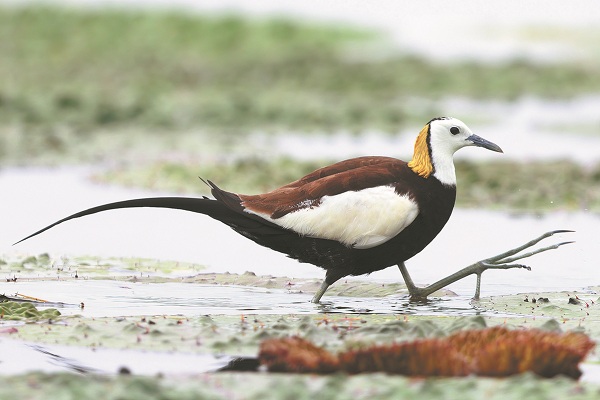

A jacana is seen on Wanjia Lake in Wuhan. CHINA DAILY
In recent years, Tanghu Lake in Wuhan, Hubei province, has become a new breeding ground for jacana, a rare water bird, following local government efforts to improve the ecology of ponds and lakes in the city.
However, the return of the bird, which is under second-class national protection, has presented local authorities and bird watchers with another challenge.
The birds fly to Wuhan in May and their reproductive period is from June to August, with a month for incubation. After the juvenile birds learn to fly in late September they move south, said Yan Jun, president of the Wuhan Bird-Watching Association.
The birds have high requirements for water quality and a living environment, and mainly inhabit freshwater lakes, ponds and marshy areas with emergent and floating plants.
"Ten years ago, jacanas were hardly seen in Wuhan. With the deepening of ecological environment protection in recent years, the number of places where they can be observed in Wuhan is increasing," Yan said. "It shows that the ecology of the lakes is getting better."
As part of efforts to keep the lakes clean, aquatic plants are removed from the lakes from July to September every year.
Li Peng, a technician from the Wuhan Forestry Workstation, said the annual clearance was a necessity as an overabundance of plants on the water's surface can obscure sunlight needed by underwater microorganisms and lead to an imbalance in the aquatic ecosystem. Rotting roots and water plant stems leave heavy deposits, creating silt problems and leading to foul-smelling water, Li added.
However, some of the plants due to be removed this year contained jacana nests as the breeding season overlapped with the scheduled annual clearance of the aquatic plants.
The bird-watching association reported the situation to the Wuhan Forestry and Parks Bureau.
Similar disputes over protection of nesting birds' habitats occurred elsewhere in the city, such as at Beitaizi Lake, where a number of nests of gray-winged gulls were found in late June. "More than 100 nests were among the water plants, occupying half of the lake's area," said Yan.
After discussions with multiple departments, the association put forward a solution. It proposed volunteers observe water birds and their nests at about 70 spots across the city and report the situation so that the water plants could remain while the birds are hatched.
The association identified 19 nesting and gathering sites for water birds at which culling of the aquatic plants was agreed to be delayed.
"We rescheduled waterweed harvesting times to avoid the breeding period of water birds," said Liu Ai, director of the bureau's wildlife and wetland protection department
"We also avoided using machines. Instead, workers were instructed to temporarily suspend harvesting in areas where nests are found until the water bird chicks have hatched."
Liu said in the past, there was no such problem as water birds were rarely seen at the lakes. As the water quality of the lakes had improved, the number of water birds breeding there also increased, she said.
"Wuhan is an international wetland city. Water birds are indicative species of wetland environmental quality, and an important component of biodiversity," she said, adding that both the government and associations have worked to observe and protect birds.
Yan said the species and number of migratory birds visiting and breeding in Wuhan had seen significant growth this year. "Refined management of the city provides a safer space for birds so that they can live in harmony with humans for a long time. It will, in return, improve the city's landscape," he said.